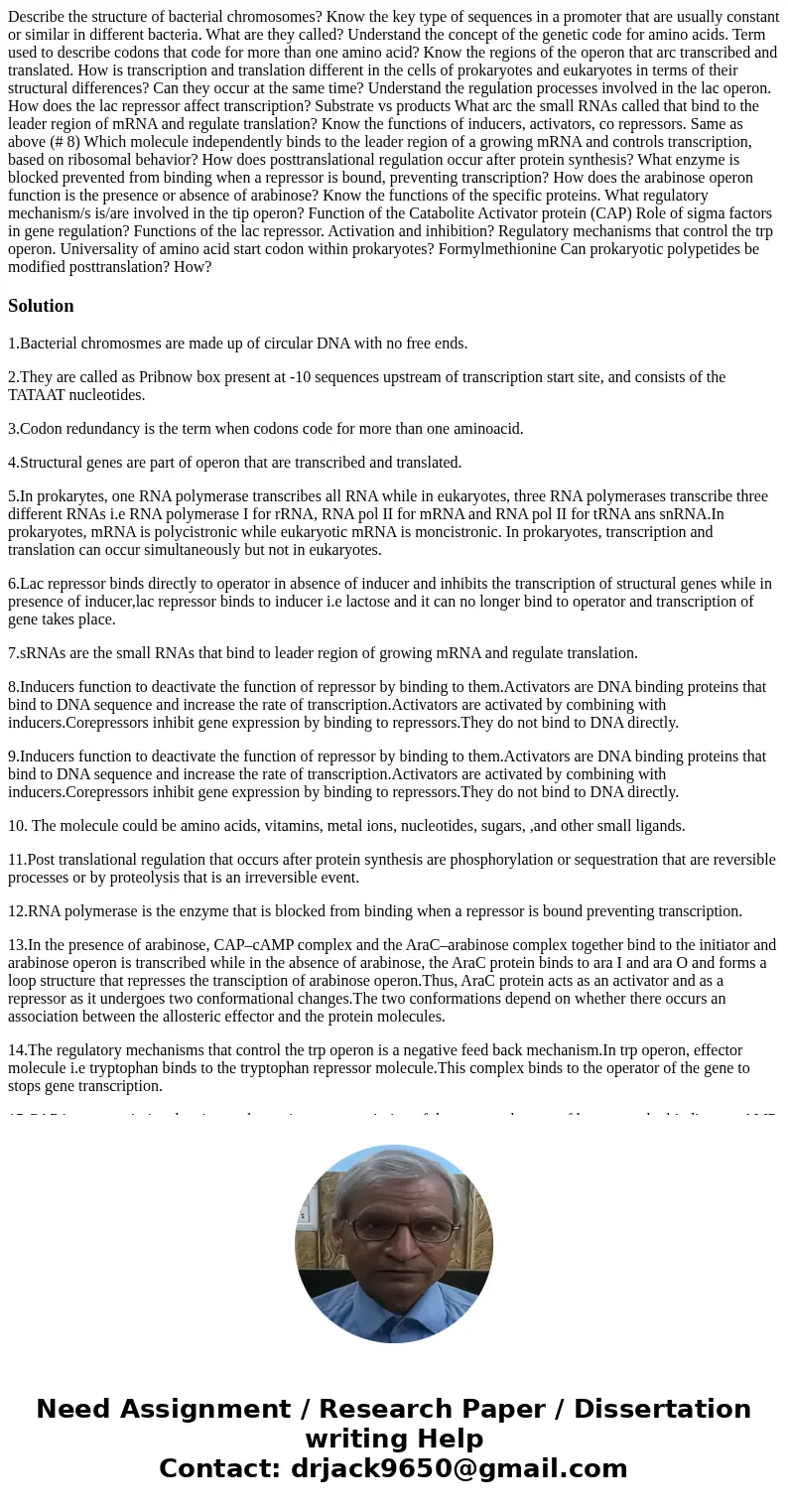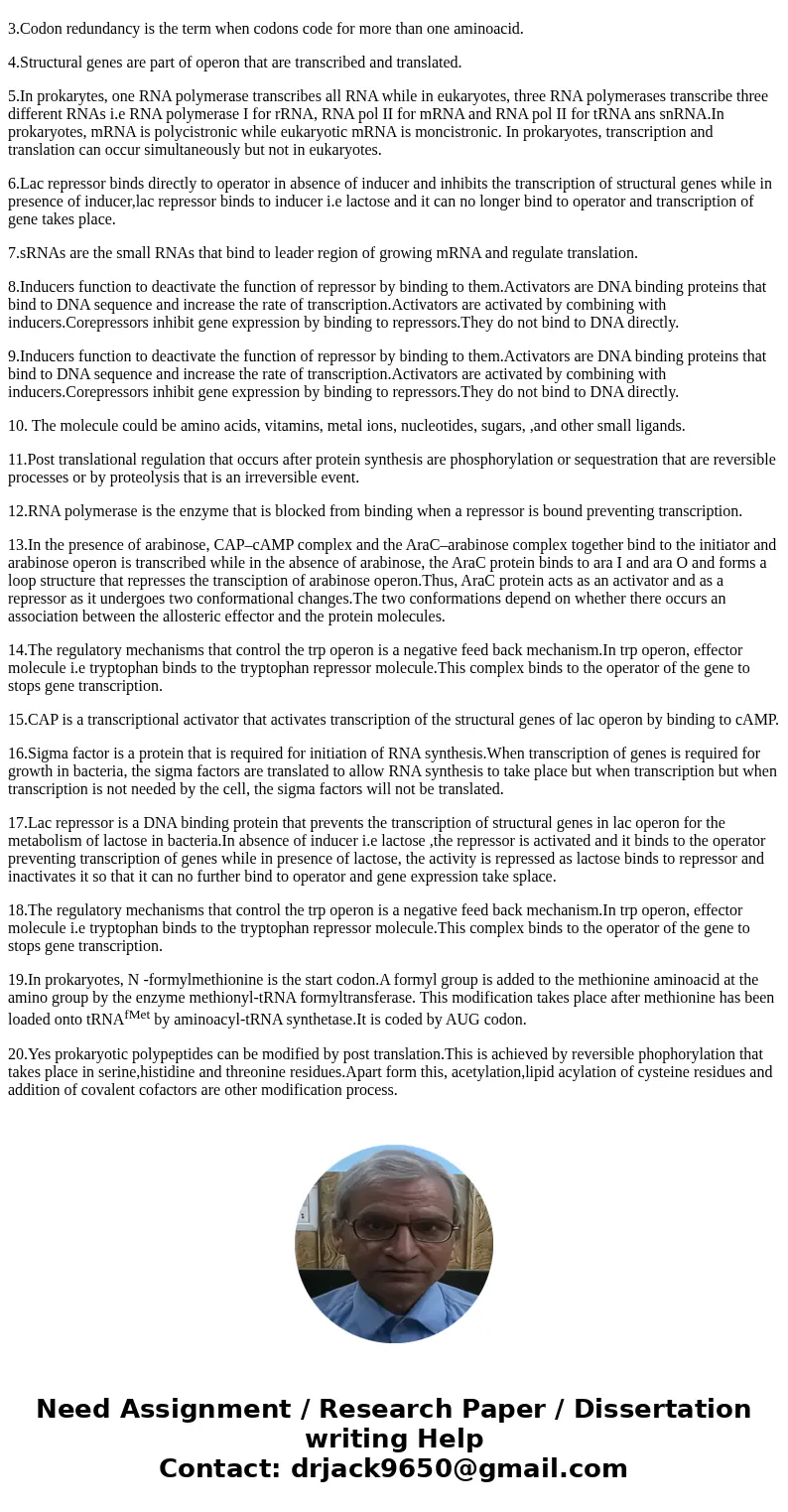Describe the structure of bacterial chromosomes Know the key
Solution
1.Bacterial chromosmes are made up of circular DNA with no free ends.
2.They are called as Pribnow box present at -10 sequences upstream of transcription start site, and consists of the TATAAT nucleotides.
3.Codon redundancy is the term when codons code for more than one aminoacid.
4.Structural genes are part of operon that are transcribed and translated.
5.In prokarytes, one RNA polymerase transcribes all RNA while in eukaryotes, three RNA polymerases transcribe three different RNAs i.e RNA polymerase I for rRNA, RNA pol II for mRNA and RNA pol II for tRNA ans snRNA.In prokaryotes, mRNA is polycistronic while eukaryotic mRNA is moncistronic. In prokaryotes, transcription and translation can occur simultaneously but not in eukaryotes.
6.Lac repressor binds directly to operator in absence of inducer and inhibits the transcription of structural genes while in presence of inducer,lac repressor binds to inducer i.e lactose and it can no longer bind to operator and transcription of gene takes place.
7.sRNAs are the small RNAs that bind to leader region of growing mRNA and regulate translation.
8.Inducers function to deactivate the function of repressor by binding to them.Activators are DNA binding proteins that bind to DNA sequence and increase the rate of transcription.Activators are activated by combining with inducers.Corepressors inhibit gene expression by binding to repressors.They do not bind to DNA directly.
9.Inducers function to deactivate the function of repressor by binding to them.Activators are DNA binding proteins that bind to DNA sequence and increase the rate of transcription.Activators are activated by combining with inducers.Corepressors inhibit gene expression by binding to repressors.They do not bind to DNA directly.
10. The molecule could be amino acids, vitamins, metal ions, nucleotides, sugars, ,and other small ligands.
11.Post translational regulation that occurs after protein synthesis are phosphorylation or sequestration that are reversible processes or by proteolysis that is an irreversible event.
12.RNA polymerase is the enzyme that is blocked from binding when a repressor is bound preventing transcription.
13.In the presence of arabinose, CAP–cAMP complex and the AraC–arabinose complex together bind to the initiator and arabinose operon is transcribed while in the absence of arabinose, the AraC protein binds to ara I and ara O and forms a loop structure that represses the transciption of arabinose operon.Thus, AraC protein acts as an activator and as a repressor as it undergoes two conformational changes.The two conformations depend on whether there occurs an association between the allosteric effector and the protein molecules.
14.The regulatory mechanisms that control the trp operon is a negative feed back mechanism.In trp operon, effector molecule i.e tryptophan binds to the tryptophan repressor molecule.This complex binds to the operator of the gene to stops gene transcription.
15.CAP is a transcriptional activator that activates transcription of the structural genes of lac operon by binding to cAMP.
16.Sigma factor is a protein that is required for initiation of RNA synthesis.When transcription of genes is required for growth in bacteria, the sigma factors are translated to allow RNA synthesis to take place but when transcription but when transcription is not needed by the cell, the sigma factors will not be translated.
17.Lac repressor is a DNA binding protein that prevents the transcription of structural genes in lac operon for the metabolism of lactose in bacteria.In absence of inducer i.e lactose ,the repressor is activated and it binds to the operator preventing transcription of genes while in presence of lactose, the activity is repressed as lactose binds to repressor and inactivates it so that it can no further bind to operator and gene expression take splace.
18.The regulatory mechanisms that control the trp operon is a negative feed back mechanism.In trp operon, effector molecule i.e tryptophan binds to the tryptophan repressor molecule.This complex binds to the operator of the gene to stops gene transcription.
19.In prokaryotes, N -formylmethionine is the start codon.A formyl group is added to the methionine aminoacid at the amino group by the enzyme methionyl-tRNA formyltransferase. This modification takes place after methionine has been loaded onto tRNAfMet by aminoacyl-tRNA synthetase.It is coded by AUG codon.
20.Yes prokaryotic polypeptides can be modified by post translation.This is achieved by reversible phophorylation that takes place in serine,histidine and threonine residues.Apart form this, acetylation,lipid acylation of cysteine residues and addition of covalent cofactors are other modification process.


 Homework Sourse
Homework Sourse